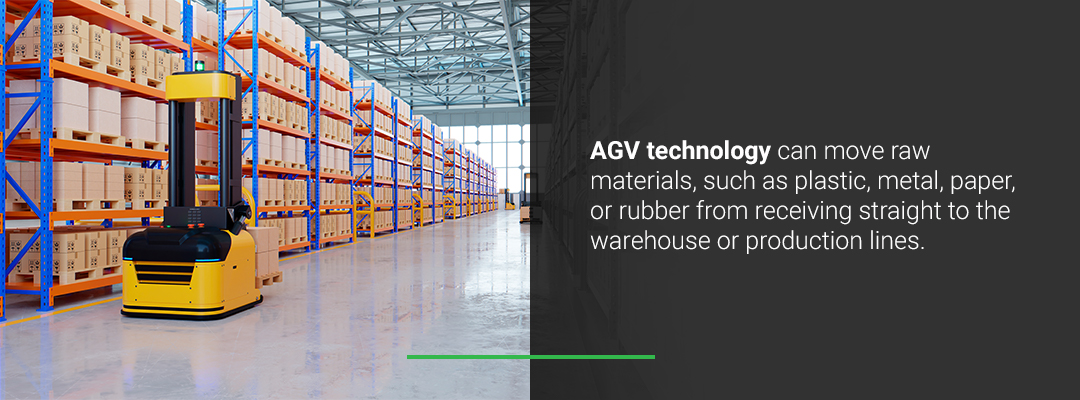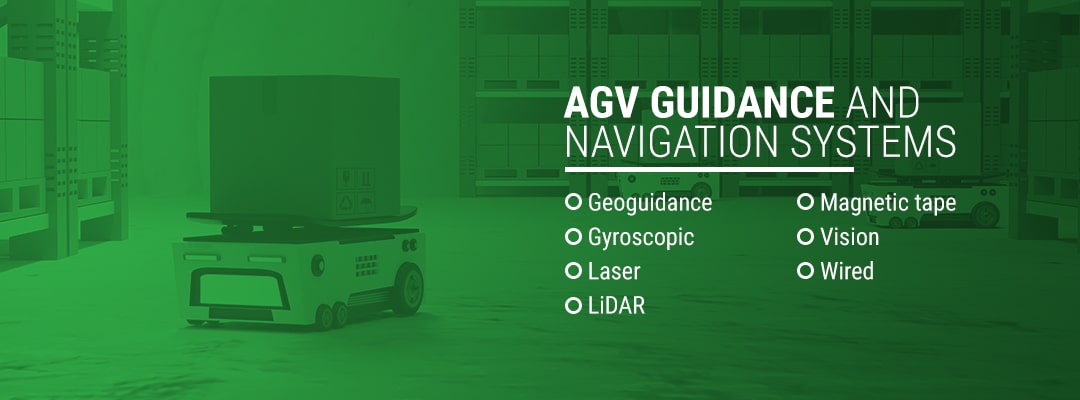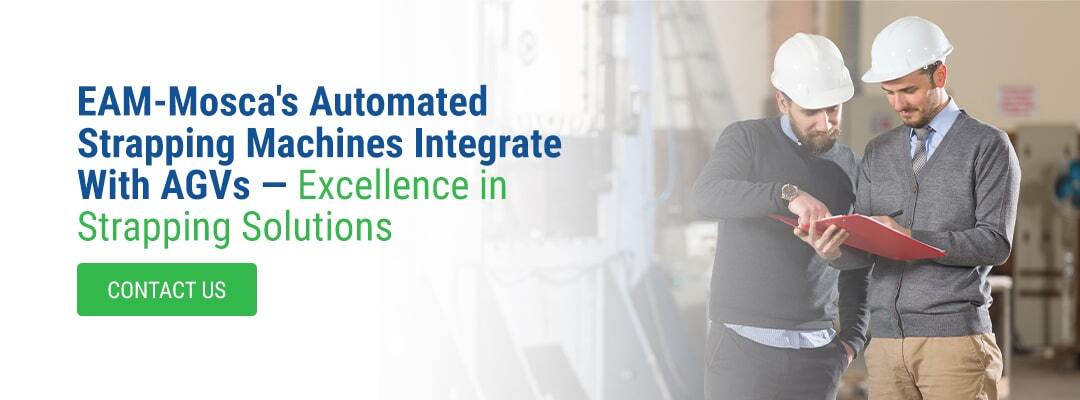Automatic Guided Vehicles: The Future of Manufacturing and Warehousing
It’s evident that driverless vehicles are no longer a dream of the future. With self-driving cars becoming more common every day, people everywhere can expect autonomous vehicles to have a permanent place on the road. However, self-driving cars aren’t only for commercial drivers — automatic guided vehicles (AGVs) in manufacturing are here, and they can help your manufacturing or warehouse processes become safer and more efficient.
In 2019, the warehouse automation market was valued at about $15 billion and is predicted to grow at a compound annual growth rate (CAGR) of 14% by 2026, reaching about $30 billion. The warehouse automation industry includes companies involved in warehouse drones, robotic arms, material handling, last-mile delivery, warehouse management systems, piece-picking robots, third party logistics, material handling software, and much more.
What Is an Automated Guided Vehicle?
Also known as self-guided vehicles, AGVs don’t require an onboard driver. Instead, these autonomous guided material handling systems travel independently throughout a distribution center, warehouse, or manufacturing facility. These innovative forms of technology use software programs to determine the vehicle’s location, position, and movement within a warehouse. Thanks to an electric motor or battery, they can operate without human interference.
These automated load carriers take the place of physical labor needed to operate manual carts, forklifts, or even conveyor belts to help transport massive volumes of materials. A few uses of AGV systems include:
- Inbound and outbound handling
- Raw materials transportation
- Work-in-progress applications
When warehouse workers have materials they need to move from receiving to storage units and vice versa, AGVs ensure the correct inventory is accessible so they can proficiently fill orders.
AGV technology can move raw materials, such as plastic, metal, paper, or rubber from receiving straight to the warehouse or production lines. This capability eliminates the need for human labor, ensuring the materials are where they need to be without delay.
These vehicles also have work-in-progress applications. By supporting production and manufacturing lines, automatic guided vehicles move materials through an efficient and repetitive process to eliminate delays.
How Do Companies Use AGVs?
AGVs complete functions that workers used to do, distribution or end-of-production-line, such as stacking pallets with a forklift or towing hefty loads. AGVs even support processing and handling activities through uses such as:
- Assembly: Transporting materials and products through the production process
- Kitting: Gathering assembly parts
- Parts delivery: Towing parts to consumption areas
- Picking: Moving orders to the loading distribution area
- Staging: Delivering pallets needed for production
- Transportation: Loading loose parts, materials, and pallets
- Transfer: Shuttling loads through high-traffic areas
- Warehousing: Transferring products to storage from stretch wrappers
A fleet of automatic guided vehicles can support industries ranging from automotive, chemical, and hospital to food, warehousing, and distribution. Because these assets operate without human guidance and are fully autonomous, automatic guided vehicle systems remove the need for human labor and reduce labor costs.
Why Are Companies Using AGVs — What Are the Benefits?
In any facility, worker safety, efficiency, and flexibility are the top priorities. With the use of AGVs, facility managers can remove workers from unsafe conditions while increasing productivity rates. Several benefits of using AGVs include:
- Accountability: Minimizes lost products because of tracking software.
- Consistent scheduling: Improves scheduling through on-time delivery and efficiency.
- Controlled costs: Compared to labor costs that fluctuate with the economy, AGV costs are predictable, and the vehicles are often acquired on a per-unit cost basis.
- Decreased operating costs: Controlled movements reduce component wear while improving traceability, traffic flow, and variability.
- Efficiency: AGVs perform predictable and reliable repetitive tasks, removing the need for unnecessary walking and physical labor.
- Eliminates human error: These vehicles reduce the need for workers to complete tedious and laborious tasks.
- Flexibility: A facility manager can change an AGV’s path as their needs evolve, or the vehicle itself can update the map across all vehicles when obstacles are present.
- Labor shortages: AGVs ensure facility managers don’t have to retain workers for specific manual tasks and can put workers on more value-added operations.
- Less product damage: AGVs operate smartly to avoid collisions and other accidents, helping protect facilities and their products while reducing waste.
- Line balancing: These vehicles can assist in line balancing multiple operations.
- Safety: A fleet of AGVs will improve worker conditions by performing heavy-duty tasks and following a guided path away from obstructions.
- Scalability: A warehouse manager can add or remove AGVs to match the changing needs of the facility.
- Space utilization: AGVs require less space to operate than other heavy equipment, like forklifts and conveyors.
With controlled movements, planned and predictable paths, and obstacle detection, AGVs in manufacturing are a safe and beneficial alternative to physical labor and human error.
How Has COVID-19 Impacted Touchless Processing With AGVs?
COVID-19 has had a positive impact on the touchless processing industry. Because the virus has created the need for physical distancing, the demand for automated solutions has increased tenfold.
For example, delivery and logistics robots are contactless delivery vehicles that decrease human contamination. These robots can deliver food and other essential items and materials. Created with cameras, sensors, and a high-performance motor, they can carry out tasks while avoiding collisions. Other similar robots can operate in high-risk environments or even disinfect public places.
There are also companion and assistance robots to help ill individuals and older adults. These capabilities have proven especially groundbreaking throughout the pandemic, as the robots can collect patient information, deliver necessary goods, and supply medication.
As for industrial automation during COVID-19, autonomous production has incredible advantages. Through remote and real-time control and predictive maintenance, AGVs can reduce the number of workers around production machines, encouraging social distancing. These machines also deliver flexible production rates.
Overall, there’s a positive industry outlook post-pandemic, emphasizing safe, autonomous, and intelligent contactless processing that maintains humanization and connectivity.
Types of AGVs
One of the most basic types of AGVs is the AGC, which is an automatic guided cart that has minimal features. An AGC’s navigation system can range from simple or complex to navigate through different environments. Often, these types support storage, sorting, and cross-docking by transporting various materials.
Other types of automated guided vehicles include:
- Autonomous mobile robots
- Forklift trucks
- Heavy burden carriers
- Tow tractors
- Unit load vehicles
Autonomous Mobile Robots
AMRs, or autonomous mobile robots, are a more sophisticated form of AGVs that are usually trackless and teachable. As the most technologically advanced type, they have intelligent navigation systems compared to the fixed systems of other AGVs. AMRs have features like camera systems and sensors to help them detect obstacles to navigate around warehouses via the most efficient path. Because AMRs can essentially perform a task perfectly, it makes for more precise actions.
Forklift AGVs
These specific AGVs perform the same functions and tasks as regular forklifts but without an operator — although some may offer a manual driving control. For example, forklift AGVs can stock, move, stack, and place materials and pallets. A heavy-duty AGV forklift can move engines, vehicles, and other major pieces of equipment.
These AGVs are an economical and efficient way to move finished products to storage or shipment while replacing lift trucks and operators, which sometimes require costly training.
Heavy Burden Solutions
A heavy burden AGV can work with cumbersome loads, including casting, plate, and coil transportation, and operate in aviation, shipbuilding, and construction vehicle manufacturing. These AGVs have larger bases, wider platforms, and more solid wheels. Depending on the type, they could have standard, omnidirectional, or pivot steering capabilities.
Tow Tractors
A tow tractor AGV, also known as a tugger automatic guided vehicle or tug, pulls load-carrying, non-powered machines behind it like a train. These machines, or driverless trains, operate on wheels to move heavy loads up to several tons over long distances with pick-up and drop-off stops along the way. A tug can pull machine components, sub-assemblies, equipment, and other materials and operates on a defined path to various locations throughout a warehouse.
Unit Load Vehicles
These vehicles carry both light and heavy loads on forks, such as individual objects, carts, bins, totes, racks, or pallets that contain several items. These types of flat table AGVs have a conveyor bed for automatic transfer between storage, stands, and other retrieval systems.
Unit Load-Strapping Machines From EAM-Mosca
At EAM-Mosca Corporation, we can seamlessly integrate our unit load-strapping machines with AGV solutions, more specifically AMR’s.
These machines present a driverless transport system with a focus on internal material flow. The AGV can connect all areas of a company — from incoming goods, warehouse, production, and shipping to transporting small load carriers, containers, trays, carts, boxes, and pallets. Even if a warehouse processes special loads, they aren’t a problem to handle, thanks to the vehicle’s mobility and high level of integration.
Another function that offers maximum flexibility is free and contour-based navigation. When changes occur in a facility environment, the system learns by using smart intelligence and updates maps across the fleet. This feature guarantees optimal performance logistics at all times and means no further construction of measures is necessary to localize the system.
Finally, with its limitless scalability and cost-efficient attributes, the AGV reduces major modifications and downtime, giving facility managers flexibility in the flow of goods.
AGVs rely on self-propulsion through the use of cameras, sensors, wires, radio waves, lasers, and software to move along defined warehouse or facility pathways. However, some guidance and navigation systems are more advanced than others, like with an AMR:
- Geoguidance: A geo-guided AGV establishes its real-time location by recognizing surrounding objects in a facility.
- Gyroscopic: Also known as inertial navigation, a gyroscopic system is where a computer tracks an AGV through embedded floor transponders to verify its location.
- Laser: An AGV that has a laser receiver and transmitter reflects off the tape placed around poles, walls, and fixed machines to calculate an object’s distance and angle from the vehicle.
- LiDAR: This natural navigation system creates a map using sensors, lasers, and cameras to calculate its position.
- Magnetic tape: An AGV with magnetic sensors follows a magnetic tape track.
- Vision: With a vision-based system, a camera records what’s on the AGVs route to help it navigate safely.
- Wired: The warehouse floor can have embedded wire paths the AGV follows through transmitted signals via its sensor or antenna.
Whatever navigation system an AGV uses, it can easily respond to changes in a facility, and facility managers can alter the routes as necessary. If a facility manager owns multiple vehicles, they can control and monitor them in real-time through wireless computer software technology. The software allows them to see each unit’s location and its routing logic and destination.
An AGVs software can communicate tasks to the vehicle like stopping, reversing, lifting, changing speeds, interfacing with other equipment, and more through radio frequency signals. AGV systems also include controlled steering, such as differential speed, steered wheel, and combination, and traffic control measures that include zone control, collision avoidance, and combination control.
Automatic Guided Vehicle Standards and Safety
The most significant advantage of relying on AGVs in a facility or warehouse is safety. By using sensors, cameras, lasers, and other forms of navigation, autonomous vehicles can avoid collisions with both workers and other objects, making them safer than manually operated machines. Each AGV must comply with safety rules and standards pertaining to its operating system, ensuring additional peace of mind. In case of emergencies, the system will halt the vehicle.
The American National Standards Institute has guidelines and standards on how facility managers can implement a safety system for their AGV fleet and achieve an acceptable residual risk. Aspects to consider include:
- Risk assessment and performance levels
- Active and passive risk reduction measures
- Operating zones like hazard, restricted, confined, load transfer, and operating
- Other elements like braking, stopping, charging, load handling, and stability
When it comes to risk reduction measures, several active safety sensors include a collision-avoidance system, pressure-sensitive bumpers, and a safety programmable logic controller (PLC). Common types of passive risk reduction measures include emergency stop systems, warning lights, alarm signals, and awareness signs.
The Industrial Truck Standards Development Foundation also provides a list of safety requirements for AGVs, including the design, operation, and maintenance of the vehicle.
Why Facilities Should Consider AGVs
If a facility manager wants to increase throughput, enhance worker safety, and protect products in their warehouse, AGVs can help them achieve these goals. The benefits of investing in an AGV range from increased efficiency levels, accountability, flexibility, and space utilization to scalability, predicted costs, and safer work zones. Instead of putting workers at risk and demanding physical labor, allocate workers to more valuable tasks by relying on autonomous vehicle systems.
EAM-Mosca’s Automated Strapping Machines Integrate With AGVs — Excellence in Strapping Solutions
EAM-Mosca Corporation has the capability to integrate machines with third-party AGVs to automate pallet strapping and secure loads. As the warehouse industry increases workloads with more products and materials to process, our technology can support warehouse and facility applications. We manufacture and distribute top-tier strapping systems to businesses that want to increase uptimes, decrease rework, and eliminate damaged goods.
Fill out a contact form to speak with one of our representatives today.






